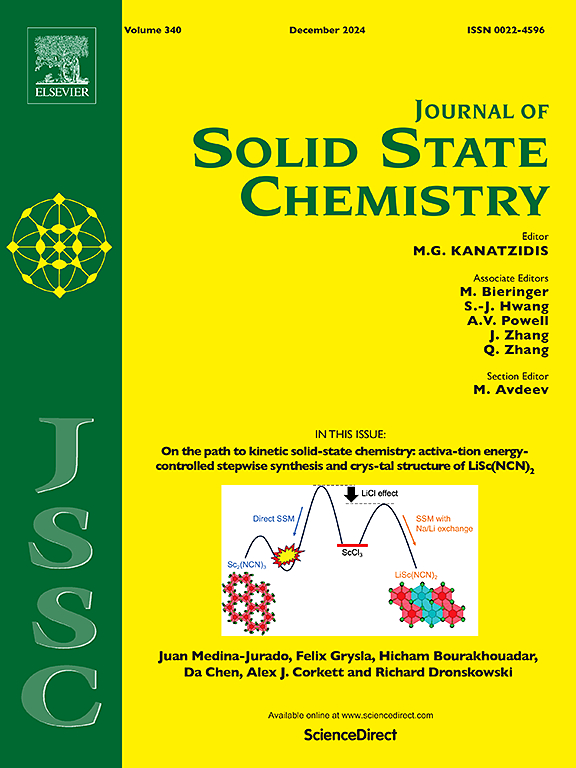Manganese-based metal-organic framework preferentially photocatalytically degraded high electronegativity groups in methyl orange
IF 3.5
3区 化学
Q2 CHEMISTRY, INORGANIC & NUCLEAR
引用次数: 0
Abstract
The photophysical properties, electronic structure, and surface active sites of metal-organic framework (MOF) photocatalysts influence their performance. In this paper, a manganese (Mn) based MOF {[Mn(L)]∙2H2O}n (Mn-MOF) and its nano photocatalyst (Mn-MOF-N) with strong visible light response (Eg = 2.48 eV) were synthesized by MnAc2∙4H2O and 2,2′-bipyridine-4,4′-dicarboxylic acid (H2L) as raw materials. X-ray single crystal diffraction analysis shows that L2− in Mn-MOF bridges adjacent Mn(II) in a μ5-η1:η1:η1:η1:η1 mode to generate a three-dimensional structure. Scanning electron microscopy (SEM) and transmission electron microscopy (TEM) show that the particle diameter of Mn-MOF-N is about 100 nm. The degradation of methyl orange (MO) by Mn-MOF-N was found to follow pseudo-first-order degradation kinetics with a photocatalytic degradation rate of 2.500 mg L−1 h−1 under optimal conditions (pH = 3.00, dosage was 0.0100 g), which is higher than that of P25 and some MOF photocatalysts. The degradation mechanism was confirmed through density functional theory (DFT) and electrospray ionization mass spectrometry (ESI-MS), revealing that the highly electronegative azo groups in MO were reduced by hydroxyl radicals and were degraded subsequently through catalytic oxidation. Mn-MOF-N emerged favourable structural stability and performance stability in cycling experiments, giving it a chance to prospective application in photocatalytic degradation of actual wastewater.

锰基金属有机骨架优先光催化降解甲基橙中的高电负性基团
金属有机骨架(MOF)光催化剂的光物理性质、电子结构和表面活性位点影响其性能。以MnAc2∙4H2O和2,2′-联吡啶-4,4′-二羧酸(H2L)为原料,合成了具有较强可见光响应(Eg = 2.48 eV)的锰基MOF {[Mn(L)]∙2H2O}n (Mn-MOF)及其纳米光催化剂(Mn-MOF- n)。x射线单晶衍射分析表明,Mn- mof中的L2−以μ5-η1:η1:η1:η1:η1模式桥接相邻的Mn(II),生成三维结构。扫描电镜(SEM)和透射电镜(TEM)分析表明,Mn-MOF-N的粒径约为100 nm。Mn-MOF-N对甲基橙(MO)的降解符合准一级降解动力学,在最佳条件(pH = 3.00,投加量为0.0100 g)下,光催化降解率为2.500 mg L−1 h−1,高于P25和部分MOF光催化剂。通过密度泛函理论(DFT)和电喷雾电离质谱分析(ESI-MS)证实了MO的降解机理,表明MO中的高电负性偶氮基团被羟基自由基还原,随后通过催化氧化被降解。Mn-MOF-N在循环实验中表现出良好的结构稳定性和性能稳定性,在实际废水的光催化降解中具有广阔的应用前景。
本文章由计算机程序翻译,如有差异,请以英文原文为准。
求助全文
约1分钟内获得全文
求助全文
来源期刊

Journal of Solid State Chemistry
化学-无机化学与核化学
CiteScore
6.00
自引率
9.10%
发文量
848
审稿时长
25 days
期刊介绍:
Covering major developments in the field of solid state chemistry and related areas such as ceramics and amorphous materials, the Journal of Solid State Chemistry features studies of chemical, structural, thermodynamic, electronic, magnetic, and optical properties and processes in solids.
 求助内容:
求助内容: 应助结果提醒方式:
应助结果提醒方式:


